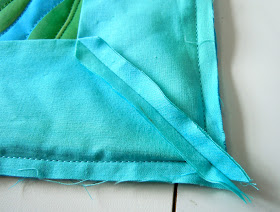So, when I make large art quilts, I like to make faced bindings, which creates a very clean finish to the front of a quilt (and you can never get a critical comment from a judge that your binding is not evenly filled either, lol).
The first thing you need to do is cut a four inch wide strip of fabric for each side of the quilt that is about 4" longer than each side.
Fold the fabric in half lengthwise and press.
After I have trimmed the quilt to size, I machine stitch the edge to secure any quilting lines that have been cut and to keep the 3 layers secured while sewing the binding on.
Pin the binding fabric to the front of the quilt with a couple extra inches of binding at either end.
With a pencil place a mark 1/4" from the top edge of the quilt, do the same at the bottom edge of the quilt. This is where you will begin and end stitching. Stitch binding down with 1/4" seam allowance.
Finger press the second binding at a 45° angle.
This finger pressed line will be your stitching line.
Bring the two binding edges together, matching up the finger pressed lines and pin.
Pull the quilt out of the way and stitch along the finger pressed line.
Stop stitching at the pencil mark.
Trim seam to 1/4" and finger press open.
Trim bulk of seam allowance away at corner being careful not to cut the stitching line.
Trim the seam allowance at an angle toward the corner.
Turn the binding to the back, poking the corner out to a point with your finger or with a blunt pointed object. Press the binding along the edge of the quilt with a hot iron. Then slip stitch the binding to the back of the quilt.
A nice clean finish!
jojo said- where did you get that measuring tool?
Jojo, That tool, made by Dritz, came in my teacher bag at festival, it is awesome! I found one here on Amazon.
Laurie said- How do you hang the quilt-with a sleeve?
Gloria Hansen has a great tutorial on making a quilt sleeve. All you need is a wood rod or slat, then put a screw eye in each end. Then the quilt can be hung by two small nails that the screw eyes can slip over on the wall.

















Good Morning Judy,
ReplyDeleteThanks so much for taking the time to post your excellent faced binding technique. The miters are wonderful and help distribute the bulk in the corners.
You are a little genius and so generous sharing what you know.
Wishing you continued Success in all you do,
LuAnn in Oregon
http://luannkessi.blogspot.com/
That is really fantastic looking! Thanks for the lovely and well-explained how-to, I'll be linking.
ReplyDeleteThank you, Judy. You make this so easy to understand. I actually needed this a short while back. Not knowing about this option, I really struggled and I'm not happy with the result. I now know just how to invisibly bind my art quilts. Normally I use small pieces of fabric and I do collage. No binding, just a lot of gluing. But, thanks to you, NOW I KNOW! Stop by and see what I do with scraps.
ReplyDeleteGlad to help Kathy!
ReplyDeleteThanks for sharing this procedure.I love the ending part where it is clean finished.Looks really amazing!
ReplyDeletethanks for your tips making this. this is very helpful for me.
ReplyDeleteStore of Mobile Phone
Movies
Yay finally,my binding problems are solved. Not as much problems, more like i don't like doing them lol. This way solves it for me. Your explanation is so easy to follow. Thanks so much for sharing Judy, really appreciate it.
ReplyDeleteLove your work!!!
Andrea.
thanks Andrea, I am glad my tutorial helped. I'm not a big fan of traditional bindings either! :-)
ReplyDeleteI really like the look of the faced binding. It has a very clean uncluttered look to it. I also like that you can't see the binding on the front. Thank you for sharing this with us.
ReplyDeleteGreat! that was really fantastic.. thanks for sharing.=D
ReplyDeleteI didn't make a binding for my first art quilt as I just stetched it like a canvas then framed it...not the reason for my comment though..I am transfixed by your even quilt stitches. I guess I need more practice! LOL. Come see my art quilt and you will know what I'm talking about! LOL! Laurel
ReplyDeleteDon't know if this post is still active...but...many thanks, Judy, for the great tutorial. Binding has always been my least favorite part of making (art)quilts, and this method was fairly painless. Now I have a question: How/where do you attach the hanging sleeve on the back? On top of all those layers? Thanks for any hints.
ReplyDelete~Susan in Ohio
Hi Susan,
ReplyDeleteI hate bindings too! lol. In fact I just realized I have a utilitarian quilt I made that needs a binding that is now 9 years old! lol. I'm going to try and tackle it in the next couple weeks before I pack everything up for my move across country.
As far as hanging sleeves go, yes they go on top of all the layers and they have to be hand stitched down. The important thing is to place it about a half inch from the top edge and make sure you have some give for the rod to fit comfortably through. I have two friends that have both made excellent tutorials:
Gloria Hansen: http://www.gloriahansen.com/weblog/?p=1488
and
Susan Bruebaker Knapp
http://www.bluemoonriver.com/QuiltSleeve.pdf